
The standard circulating coinage of the United Kingdom, British Crown Dependencies and British Overseas Territories is denominated in pennies and pounds sterling, and ranges in value from one penny sterling to two pounds. Since decimalisation, on 15 February 1971, the pound has been divided into 100 pence. Before decimalisation, twelve pence made a shilling, and twenty shillings made a pound.
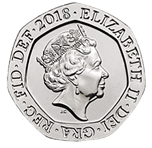
The British decimal twenty pence coin is a denomination of sterling coinage worth 1⁄5 of a pound. Like the 50p coin, it is an equilateral curve heptagon. Its obverse has featured the profile of Queen Elizabeth II since the coin's introduction on 9 June 1982. Four different portraits of the Queen have been used; the latest design by Jody Clark was introduced in 2015. The second and current reverse, featuring a segment of the Royal Shield, was introduced in 2008.

The British decimal halfpenny coin was a denomination of sterling coinage introduced in February 1971, at the time of decimalisation, and was worth 1⁄200 of one pound. It was ignored in banking transactions, which were carried out in units of 1p.

Sterling is the currency of the United Kingdom and nine of its associated territories. The pound is the main unit of sterling, and the word pound is also used to refer to the British currency generally, often qualified in international contexts as the British pound or the pound sterling.
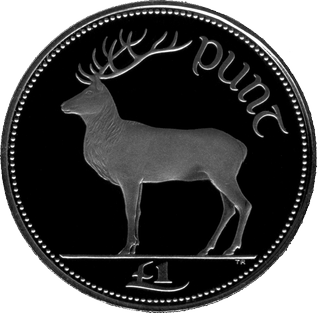
The pound was the currency of Ireland until 2002. Its ISO 4217 code was IEP, and the symbol was £ The Irish pound was replaced by the euro on 1 January 1999. Euro currency did not begin circulation until the beginning of 2002.

Decimal Day in the United Kingdom and in Ireland was Monday 15 February 1971, the day on which each country decimalised its respective £sd currency of pounds, shillings, and pence.
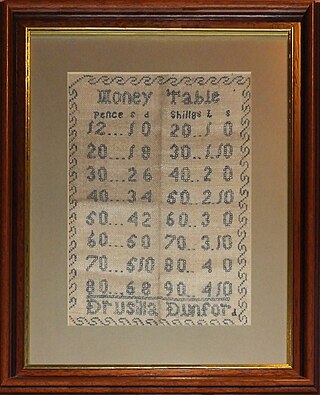
£sd, spoken as "pounds, shillings and pence", is the popular name for the pre-decimal currencies once common throughout Europe. The abbreviation originates from the Latin currency denominations librae, solidi, and denarii. In the United Kingdom, these were referred to as pounds, shillings, and pence.

The British decimal twenty-five pence (25p) coin was a commemorative denomination of sterling coinage issued in four designs between 1972 and 1981. These coins were a post-decimalisation continuation of the traditional crown, with the same value of a quarter of a pound. Uniquely in British decimal coinage, the coins do not have their value stated on them. This is because previous crowns rarely did so. The British regular issue coin closest to the coin's nominal value is the twenty pence coin.
The pound, or Manx pound, is the currency of the Isle of Man, at parity with sterling. The Manx pound is divided into 100 pence. Notes and coins, denominated in pounds and pence, are issued by the Isle of Man Government.
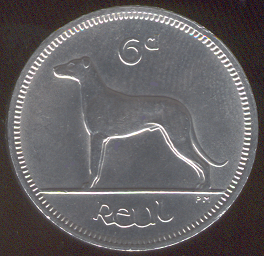
The sixpence coin was a subdivision of the pre-decimal Irish pound, worth 1⁄40 of a pound or 1⁄2 of a shilling. The Irish name réal is derived from the Spanish real; for most of the 19th century, a pound sterling was equal to five U.S. dollars, and a dollar was equal to eight reales, so that a real was equal to 1⁄40 of a pound. The variant spelling reul was used in the Coinage Act 1926, and appeared on the coins themselves even after a 1947 spelling reform established réal as the standard.
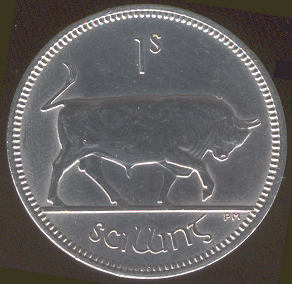
The shilling (1s) coin was a subdivision of the pre-decimal Irish pound, worth 1⁄20 of a pound. Worth 12d or half of a Florin.
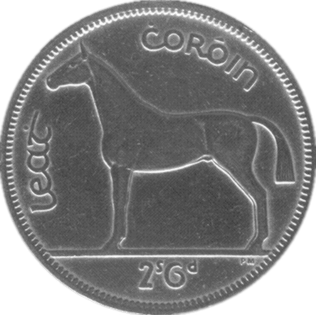
The half crown coin was a subdivision of the pre-decimal Irish pound, worth 1⁄8 of a pound. The half crown was commonly called "two and six" due to its value of two shillings and sixpence.
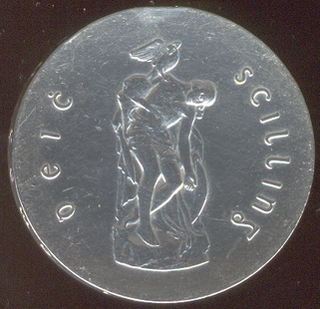
The ten shilling (10s) coin was a one-off commemorative coin issued in Ireland in 1966 to mark the 50th anniversary of the Easter Rising. Ten shillings was a subdivision of the pre-decimal Irish pound, worth 1⁄2 of an Irish pound, making this the highest-value coin in the pre-decimal system.
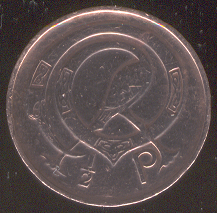
The decimal halfpenny coin was the smallest denomination of the Irish pound. It was first issued when the Irish currency was decimalised on Decimal Day, 15 February 1971. It was one of three new designs introduced all in bronze and featuring ornamental birds on the reverse. The coin value was weakened by inflation and very few were produced beyond the initial run for 1971. It was removed from circulation and demonetised on 1 January 1987.

The decimal one penny (1p) coin was the second-smallest denomination of the Irish pound. There were 100 pennies (pence) to the pound. The coin was first issued on Decimal Day, 15 February 1971. It was the second of three new designs introduced all in bronze, the others being a half-penny and a two pence coin. All featured ornamental birds designed by Irish artist Gabriel Hayes on the reverse.
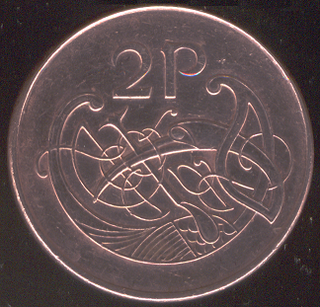
The two pence (2p) coin was the third smallest denomination of the Irish pound, being worth 1⁄50 of a pound. It was first issued on Decimal Day, 15 February 1971. The coin was minted until 2000. It was the third of three new designs introduced all in bronze, the others being the halfpenny and penny. All featured ornamental birds on the reverse.

The five pence (5p) coin was a subdivision of the Irish pound. It was introduced in Ireland on Decimal Day, 15 February 1971 and reused the design on the shilling coin produced for the Irish Free State in 1928. Some shilling coins remained in circulation until the early 1990s, with the same nominal value as the five pence coin.

The ten pence (10p) coin was a subdivision of the Irish pound. It was used in the Republic of Ireland from 1969 to 2002, with its last minting issue in 2000. It replaced the florin coin, of which it shared its design. Two different designs of the coin exist, both featuring a salmon on the reverse. The second was introduced in 1993 and is smaller, due to the reduction of the coin's value by inflation.

The fifty pence (50p) coin was a subdivision of the Irish pound. It was introduced in Ireland on 17 February 1970. It replaced the ten-shilling coin and ten-shilling note when decimalised, and due to this conversion was introduced a year before Decimal Day in 1971.
There have been three sets of coins in Ireland since independence. In all three, the coin showed a Celtic harp on the obverse. The pre-decimal coins of the Irish punt had realistic animals on the reverse; the decimal coins retained some of these but featured ornamental birds on the lower denominations; and the euro coins used the common design of the euro currencies. The pre-decimal and original decimal coins were of the same dimensions as the same denomination British coins, as the Irish punt was in currency union with the British pound sterling. British coins were widely accepted in Ireland, and conversely to a lesser extent. In 1979 Ireland joined the Exchange Rate Mechanism and the Irish punt left parity with sterling; coin designs introduced after this differed between the two countries.


















